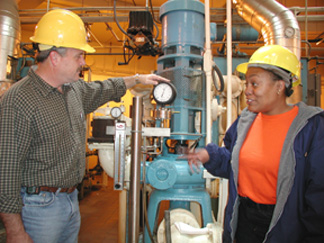Reclamation Plant Heat and Electrical Power Generation from Digester Gas
Project taps wastewater treatment by-product to generate electrical power
May 1, 2003
|
The new cogeneration system will utilize lean burn engine technology to meet current state air emission standards. The project has been granted an air quality permit by the Utah State Division of Air Quality.
Brown & Caldwell provided the engineering services for the $3.5 million project and the construction contract was awarded to Ellsworth Paulsen Construction Co., located in American Fork, Utah. Construction began on January 15, 2003 and is scheduled to be completed June 1, 2004.
The new system will generate 16,800 kWh of electrical power per day and heat the treatment plant's digesters by circulating cooling water heated by the generating engines.
The 56 million gallon per day water reclamation plant serves the growing population of Salt Lake City, generating 450,000 cubic feet/day (4,500 therms) of methane gas. Currently this energy source is being flared to the atmosphere.
The cogeneration system will provide 60 percent of the wastewater treatment plant's current annual electrical power demand to operate pumps and other process equipment. The recovered heated water will provide 100 percent of the necessary heated water to four anaerobic sludge digesters and various building heaters. The heat captured from the operating generators will be transferred by means of a heat recovery system to the digester complex to heat four new spiral heat exchangers. The spirals are more efficient and easier to maintain than the old water bath tube heat exchangers. The spiral heat exchanges are included as part of the construction contract.
Two new generators can operate on methane, natural gas or a blend of the two. Besides generating a portion of the daily electrical power needs, the cogeneration system provides emergency backup power in the event the commercial power source is disrupted.
Water reclamation manager Jon Adams notes, "This project will save up to $250,000 per year in energy costs and utilizes a valuable by-product of the treatment process." According to Adams, based on estimated escalating power costs, the estimated cost savings will pay for the project in seven to ten years. Besides the direct cost savings benefits, the project will reduce emissions into the environment by eliminating the current practice of flaring the treatment methane into the atmosphere.
Included in the construction project are improvements to the building structure to bring it up to current seismic standards.
"Air quality standards have increased over the years," said Adams, "Likewise, cogeneration technology has also improved allowing us to meet stringent air emissions standards." According to Adams, he looks forward to no longer flaring the methane gas and instead putting it to beneficial work.
